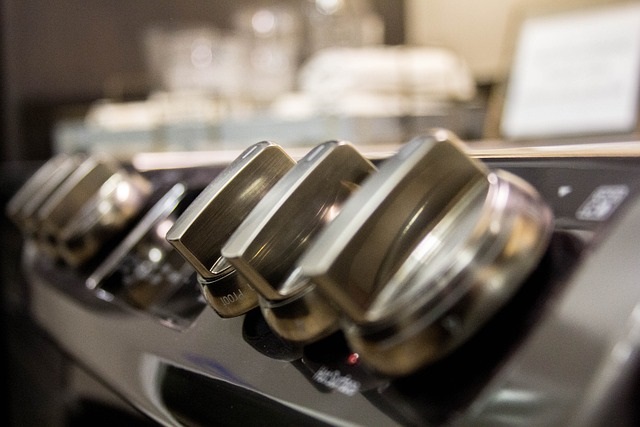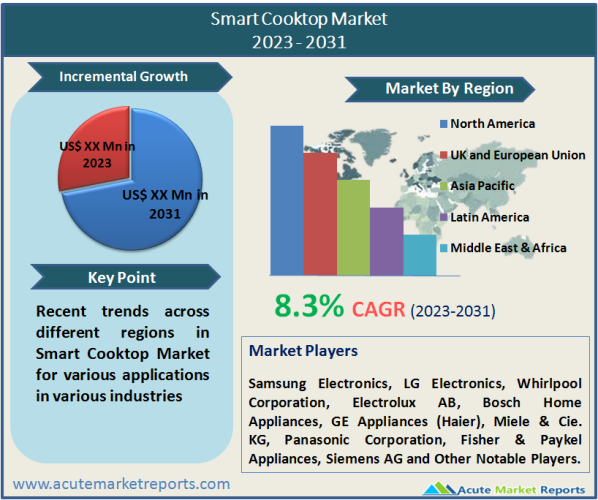
The Smart Cooktop Market is a rapidly growing market that is witnessing significant demand due to advancements in smart home technologies and changing consumer preferences toward connected and convenient cooking solutions. The market revenue has been steadily increasing over the past few years, driven by the growing adoption of smart home automation systems and increasing consumer awareness about energy-efficient cooking appliances. The market is projected to continue its upward growth trajectory in the coming years. The global smart cooktop market is expected to grow at a CAGR of 8.3% during the forecast period of 2024 to 2032. Smart cooktops provide many features and functionalities that make cooking smarter and more convenient. These cooktops are equipped with advanced technologies such as touch controls, voice commands, Wi-Fi connectivity, and smart sensors that allow users to control and monitor their cooking activities remotely through smartphone apps or other connected devices. Some smart cooktops also offer integration with other smart home devices, such as smart ovens, smart exhaust fans, and smart assistants, for seamless automation and enhanced cooking experiences.

Increasing Consumer Demand for Connected and Convenient Kitchen Appliances
The demand for smart cooktops is being driven by consumers seeking connected and convenient kitchen appliances that offer advanced features and functionalities. With the proliferation of smart home technologies, consumers are increasingly looking for ways to make their homes more intelligent and efficient. Smart cooktops, with features such as touch controls, voice commands, and Wi-Fi connectivity, allow users to control and monitor their cooking activities remotely, providing greater convenience and flexibility. For instance, users can preheat the cooktop or adjust cooking settings from their smartphones, saving time and effort. According to a survey conducted by Deloitte, 42% of consumers in the United States own a smart home device, indicating the increasing consumer interest in connected home appliances.
Growing Awareness about Energy-Efficient Cooking
Energy-efficient cooking has become a key consumer consideration due to the increasing focus on environmental sustainability and energy conservation. Smart cooktops are designed with advanced technologies, such as smart sensors and timers, that optimize cooking time and energy usage. For example, smart cooktops can automatically adjust heat levels or shut off after a certain period of inactivity, helping to reduce energy waste. This resonates with environmentally-conscious consumers who are seeking energy-efficient solutions for their homes. According to a report by the U.S. Department of Energy, smart cooktops can potentially save up to 10% of energy consumption compared to traditional cooktops.
Technological Advancements in Smart Home Automation Systems
Advancements in smart home automation systems have played a significant role in driving the demand for smart cooktops. Smart cooktops can integrate with other smart home devices, such as smart ovens, smart exhaust fans, and smart assistants, to create a seamless and automated cooking experience. For example, users can set up customized cooking routines that automatically adjust cooking settings based on the type of dish being cooked, or receive notifications when the cooking is complete. This level of automation and convenience appeals to tech-savvy consumers who are looking for sophisticated and integrated smart home solutions. The increasing prevalence of smart home automation systems, along with the growing interoperability of smart devices, is expected to drive the adoption of smart cooktops in the coming years.
High Initial Cost and Complex Installation Process
One significant restraint for the smart cooktop market is the high initial cost and complex installation process associated with these advanced appliances. Smart cooktops often come with premium features and advanced technologies, which can make them more expensive than traditional cooktops. The higher price point may limit the affordability for some price-sensitive consumers or budget-conscious households, potentially hindering the widespread adoption of smart cooktops. The average price of a smart cooktop can range from $500 to $2,500, depending on the brand, features, and technology. Furthermore, the installation process for smart cooktops may require technical expertise and modifications to the existing electrical and gas connections in the kitchen, which can be complex and time-consuming. This may pose challenges for some consumers who may not be familiar with such installation processes or may require professional assistance, adding additional costs to the overall purchase and installation of a smart cooktop.
Induction Cooktop Remains a Growth Leader
The CAGR for the induction cooktop market is projected to grow at a CAGR of 8.5% during the forecast period of 2024 to 2032. The revenue percent of induction cooktops is expected to grow significantly as well, accounting for a significant share of the overall smart cooktop market revenue. Induction cooktops use magnetic fields to directly heat the cookware, making them highly efficient, safe, and precise. These cooktops have seen increasing demand due to their advanced features, energy-efficient operations, and ease of use. One of the notable trends of induction cooktops is the integration of smart features, such as Wi-Fi connectivity, voice control, and app-based controls, allowing users to control the cooktop remotely using their smartphones or other smart devices. This enables convenient and personalized cooking experiences, increasing adoption among tech-savvy consumers. Manufacturers and market players in the smart cooktop market are focusing on innovation and product development in the induction cooktop segment, leveraging advanced technologies to enhance cooking experiences, improve energy efficiency, and offer seamless integration with smart home systems.
Built-in Smart Cooktops Dominate the Market by Installation
In terms of revenue and CAGR, the built-in cooktop segment is expected to be one of the leading segments in the smart cooktop market. The increasing adoption of built-in cooktops in modern kitchens, driven by their sleek design, ease of installation, and customization options, is expected to contribute to the highest revenue and highest CAGR among the different installation types of smart cooktops. The built-in cooktop segment is expected to witness a significant CAGR during the forecast period. The CAGR for the built-in cooktop market is projected to be around 7.5% during the forecast period of 2024 to 2032. The revenue percent of built-in cooktops is also expected to grow significantly, accounting for a substantial share of the overall smart cooktop market revenue. Manufacturers and market players in the smart cooktop market are focusing on offering innovative and customizable options in built-in cooktops, such as different burner configurations, control options, and design aesthetics to cater to evolving consumer preferences. This is likely to drive the growth of the built-in cooktop segment in the smart cooktop market, shaping the market dynamics in the coming years.
North America remains the Global Leader, While APAC Leads the Growth
North America held the largest revenue share in 2023. North America has been a prominent market for smart cooktops, with a high adoption rate among consumers. The region has witnessed a growing demand for smart home technologies, including smart cooktops, due to factors such as convenience, energy efficiency, and connectivity. The market in North America is characterized by the presence of key players, advanced technological infrastructure, favorable government initiatives for smart home adoption, and higher disposable income of consumers. These factors have contributed to the region's significant revenue percentage and CAGR in the smart cooktop market. The Asia Pacific region is emerging as a lucrative market for smart cooktops, with growing consumer awareness, rising disposable income, and increasing urbanization driving the demand for smart home technologies. Countries such as China, Japan, South Korea, and India are witnessing significant growth in the smart cooktop market. The market in Asia Pacific is characterized by the growing adoption of smart home solutions, expanding middle-class population, and changing consumer preferences toward technologically advanced kitchen appliances. These factors are contributing to the region's notable CAGR in the smart cooktop market.
Market Competition to Intensify During the Forecast Period
The smart cooktop market is fiercely competitive, with leading players adopting various strategies to gain an edge in the market. One of the key competitive trends is product innovation, with companies constantly striving to develop advanced features such as voice control, wireless connectivity, touch controls, and safety sensors to enhance the user experience and meet changing consumer demands. For example, companies like Samsung Electronics, LG Electronics, Whirlpool Corporation, and Bosch Home Appliances have been at the forefront of introducing innovative smart cooktop models with cutting-edge technologies to stay ahead of the competition. Strategic partnerships and collaborations are also prominent in the smart cooktop market, with companies joining forces with other companies to leverage their strengths and expand their market reach. This includes collaborations with smart home automation companies, appliance manufacturers, and technology providers to integrate smart cooktops into broader smart home ecosystems. Such partnerships enable companies to offer more comprehensive and connected solutions to consumers, enhancing their competitive advantage. The top players in the smart cooktop market, such as Samsung Electronics, LG Electronics, Whirlpool Corporation, Electrolux AB, Bosch Home Appliances, GE Appliances (Haier), Miele & Cie. KG, Panasonic Corporation, Fisher & Paykel Appliances, Siemens AG and Other Notable Players are known for their market presence, product offerings, and customer base.
Historical & Forecast Period
This study report represents analysis of each segment from 2022 to 2032 considering 2023 as the base year. Compounded Annual Growth Rate (CAGR) for each of the respective segments estimated for the forecast period of 2024 to 2032.
The current report comprises of quantitative market estimations for each micro market for every geographical region and qualitative market analysis such as micro and macro environment analysis, market trends, competitive intelligence, segment analysis, porters five force model, top winning strategies, top investment markets, emerging trends and technological analysis, case studies, strategic conclusions and recommendations and other key market insights.
Research Methodology
The complete research study was conducted in three phases, namely: secondary research, primary research, and expert panel review. key data point that enables the estimation of Smart Cooktop market are as follows:
Market forecast was performed through proprietary software that analyzes various qualitative and quantitative factors. Growth rate and CAGR were estimated through intensive secondary and primary research. Data triangulation across various data points provides accuracy across various analyzed market segments in the report. Application of both top down and bottom-up approach for validation of market estimation assures logical, methodical and mathematical consistency of the quantitative data.
| ATTRIBUTE | DETAILS |
|---|---|
| Research Period | 2022-2032 |
| Base Year | 2023 |
| Forecast Period | 2024-2032 |
| Historical Year | 2022 |
| Unit | USD Million |
| Segmentation | |
Type
| |
Installation
| |
Width
| |
Control Type
| |
Number of Burners
| |
End-use
| |
Price
| |
Distribution Channel
| |
|
Region Segment (2022-2032; US$ Million)
|
Key questions answered in this report